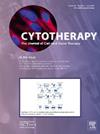大规模制造免疫抑制细胞外囊泡用于人体临床试验。
IF 3.2
3区 医学
Q2 BIOTECHNOLOGY & APPLIED MICROBIOLOGY
引用次数: 0
摘要
背景:人间充质间质细胞(MSCs),特别是沃顿氏果冻来源的间充质间质细胞(WJMSCs),部分通过其分泌的小细胞外囊泡(sev),为复杂的免疫疾病(如移植物抗宿主病(GVHD))提供了重要的治疗潜力。这些sev表现出关键的免疫调节特性,包括在健康供体细胞和病理环境中都能抑制t细胞活化。尽管前景看好,但为msc衍生sev开发稳健、可扩展且符合良好生产规范(GMP)的生产工艺以满足临床需求,这一重大挑战阻碍了广泛的临床应用。方法:为了解决sEV生产中的关键障碍,本研究详细介绍了wjmsc衍生sEV的可靠和可扩展制造平台的开发和验证。该工艺使用GMP扩展的WJMSC培养基,由培养的低传代细胞产生,并在可扩展的2-L和6-L批量中进行处理。该平台采用了一种顺序方法,包括切向流过滤(TFF)以获得有效的初始浓度,然后采用尺寸排除色谱(SEC)对sev进行全面的最终纯化。结果:集成TFF-SEC制造方法导致纳米颗粒显著富集,表明2-L和6-L批次的tff后颗粒浓度分别增加了16.9倍和36倍。两批纯化的sev显示出非常相似的平均大小范围,从142±2 nm到156±2 nm,并且显示CD9和CD81标记,而不表达负标记calnexin。这些wjmsc衍生的sev保持了其生物活性,有效地抑制了体外的细胞活化。此外,从2-L和6-L批次纯化的sev通过低温电子显微镜(cryo-EM)观察到结构完整,抑制免疫检查点配体PD-L1呈阳性。结论:在本研究中,我们报告了一个可靠的大规模制造框架,结合TFF和SEC来制造wjmsc衍生的sev。已建立的标准操作程序(sop)将有助于指导工业规模、临床级wjmsc衍生sEV制造的设计和建立。这项工作提供了一条实用的途径,有望促进更广泛的开发,并加速这些wjmsc衍生的sev作为各种人类疾病的有效的无细胞治疗剂的临床转化,从而显著推进了该领域的发展。本文章由计算机程序翻译,如有差异,请以英文原文为准。
Large-scale manufacturing of immunosuppressive extracellular vesicles for human clinical trials
Background
Human mesenchymal stromal cells (MSCs), particularly Wharton's jelly-derived MSCs (WJMSCs), offer significant therapeutic potential for complex immune conditions such as graft versus host disease (GVHD), in part through their secreted small extracellular vesicles (sEVs). These sEVs exhibit crucial immunomodulatory properties, including suppression of T-cell activation demonstrated both in healthy donor cells and in pathologic contexts. Despite this promise, widespread clinical application is impeded by substantial challenges in developing robust, scalable, and Good Manufacturing Practice (GMP)–compliant manufacturing processes for MSC-derived sEVs to meet clinical demand.
Methods
To address the critical barriers in sEV production, this study details the development and validation of a reliable and scalable manufacturing platform for WJMSC-derived sEVs. The process utilized GMP expanded WJMSC culture medium, generated from cultured low-passage cells and processed in scalable 2-L and 6-L batch volumes. This platform employed a sequential approach involving tangential flow filtration (TFF) for efficient initial concentration followed by size-exclusion chromatography (SEC) for comprehensive final purification of sEVs.
Results
The integrated TFF-SEC manufacturing approach resulted in a significant enrichment of nanoparticles, demonstrating up to a 16.9- and 36-fold increase in particle concentration post-TFF from the 2-L and 6-L batches, respectively. Two batches of purified sEVs demonstrated very similar mean size ranges, from 142 ± 2 nm to 156 ± 2 nm, and displayed the markers CD9 and CD81 while not expressing the negative marker calnexin. Those WJMSC-derived sEVs maintained their biological activity, effectively suppressing - cell activation in vitro. Furthermore, the purified sEVs from both 2-L and 6-L batches demonstrated an intact structure observed by cryogenic electron microscopy (cryo-EM), positivity for the inhibitory immune checkpoint ligand PD-L1.
Conclusion
In this study, we report a reliable large-scale manufacturing framework that combines TFF and SEC to manufacture WJMSC-derived sEVs. The established standard operating procedures (SOPs) will help guide the design and establishment of industrial-scale, clinical-grade WJMSC-derived sEV manufacturing. This work significantly advances the field by offering a practical pathway that is anticipated to facilitate the broader development and accelerate the clinical translation of these WJMSC-derived sEVs as potent, cell-free therapeutic agents for various human diseases.
求助全文
通过发布文献求助,成功后即可免费获取论文全文。
去求助
来源期刊

Cytotherapy
医学-生物工程与应用微生物
CiteScore
6.30
自引率
4.40%
发文量
683
审稿时长
49 days
期刊介绍:
The journal brings readers the latest developments in the fast moving field of cellular therapy in man. This includes cell therapy for cancer, immune disorders, inherited diseases, tissue repair and regenerative medicine. The journal covers the science, translational development and treatment with variety of cell types including hematopoietic stem cells, immune cells (dendritic cells, NK, cells, T cells, antigen presenting cells) mesenchymal stromal cells, adipose cells, nerve, muscle, vascular and endothelial cells, and induced pluripotential stem cells. We also welcome manuscripts on subcellular derivatives such as exosomes. A specific focus is on translational research that brings cell therapy to the clinic. Cytotherapy publishes original papers, reviews, position papers editorials, commentaries and letters to the editor. We welcome "Protocols in Cytotherapy" bringing standard operating procedure for production specific cell types for clinical use within the reach of the readership.
 求助内容:
求助内容: 应助结果提醒方式:
应助结果提醒方式:


